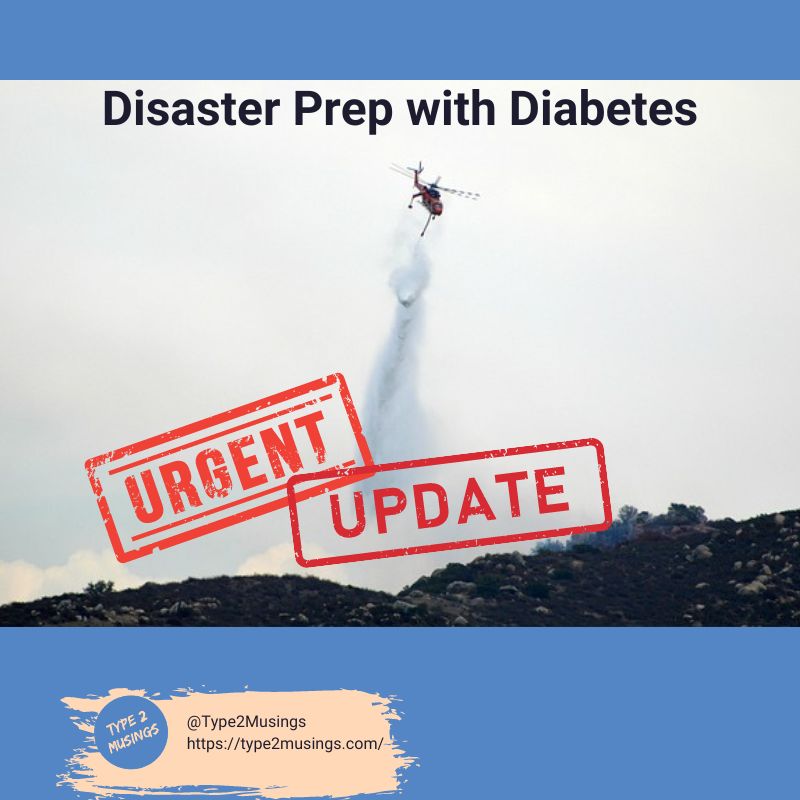It was about five years ago that I wrote my first article about the importance of disaster preparedness when living with diabetes. Looking back, the advice I gave then seems almost quaint. It was all about making sure your devices were charged up and you had a backup battery. These days disaster prep requires so much more.
Every place I’ve ever lived has had the potential for a disaster or emergency. In California there were earthquakes. But they don’t happen very often and are generally small. Then, in Hawaii there were hurricanes, tropical storms, tsunami warnings, and lava flows. Those give more warning and need more active preparation. And now that I’m back on the mainland, wildfires have become very common. This summer in the Pacific Northwest I don’t think we’ve had a week without an active wildfire in either Washington or Oregon. And though the flames have been miles away, I’ve still been exposed to a fair amount of smoke and haze.
I am astounded at how quickly the seriousness and frequency of these events have accelerated in just the past five years.
These days being prepared for a potential disaster (natural or man-made) is about more than sheltering in place and having battery backups. Today we need to be ready for a whole range of responses, everything from sheltering in place to evacuating on short notice. And we have to face the possibility that when all is said and done there won’t be anything to come back to.
How to prepare for a disaster
Pack yourself a grab-and-go bag. This is a kit containing all the things you need to manage your diabetes during an emergency. Prepare it in advance. Check its contents regularly to make sure nothing has expired or changed. When you need to, update the contents so that it stays current with your needs.
Figuring out what you need to put in your bag will take some work. Make a list of all the things you need (medications, medical devices, apps, supplies, etc.) to manage your diabetes for at least a week. Then consider which of those things might need a backup. For example, if your CGM stops working do you have a glucometer to use instead? How about testing supplies and batteries or a charging cable?
Collect any relevant contact info. Be sure to include the customer service numbers for any medical devices you use along with the device model and serial number.
Keep in mind that responding organizations, like Red Cross/Red Crescent, will likely have general supplies like bottled water and toilet paper. So you can pack less of that. But they are unlikely to have diabetes-specific supplies.
Once you figure out what you need in your grab-and-go bag, pack it all up securely so that it stays cool and dry. If you use insulin or an injectable you’ll most likely also need some kind of cool bag or cool box.
Be sure to pack all of your things in a container that you can easily move and carry. For example, I keep all my diabetes supplies and tablets in a small carry-on rolling suitcase. And all my refrigerated medicines are in an insulated lunch bag. Put the insulated lunch bag in my suitcase and I’m ready to roll.
Understand the kinds of risks your community faces. Knowing the kinds of disaster (natural or man-made) most likely to hit where you are will help you refine your preparations. Local governments generally identify the kinds of disasters and disruptions their communities are vulnerable to. Often they publish reports that document who will respond and how in an emergency.
From these community plans, you may learn planned evacuation routes and emergency shelter locations. This will help you anticipate how far you might have to travel for help and how to get there.
Identify what agencies and organizations are most likely to respond and offer follow-up help. Some combination of government and non-governmental organizations usually step in to help people affected by disasters and emergencies. Red Cross/Red Crescent are often among the first on the scene. However other humanitarian and religious organizations can provide help and support to those affected as well. Some will be better equipped to help with medical supplies and treatment than others. You’ll want to get an idea of what level of support will most likely be available.
National diabetes organizations, like the American Diabetes Association, often have emergency hotlines to help people replace their medications and access medical treatment. Locate this kind of diabetes organization for your country and make a note of their contact information.
Medical device manufacturers, through their customer service department, might also offer assistance to their users affected by disasters. If you use a CGM, insulin pump, or some other medical device be sure to store its related information (manufacturer, model, and serial number) securely.
Make a personal communications plan. In advance, arrange with your friends and family to have a designated point of contact. This is the person you will contact to let them know where you are and if you are safe. Instead of having many people trying to contact you or relying on social media, people can turn to your designated point of contact.
If you find yourself leaving your point person a voicemail, be sure to leave complete information. Along with your status be sure to tell them the date and time you are calling and where you are located.
Every emergency is unique
It’s hard to say exactly what you need to pack and prepare. So much depends on where you are, your particular diabetes care routine, and the kinds of support available to you. The important thing is to start getting prepared. You never know when disaster will strike. And some preparation is better than none.

